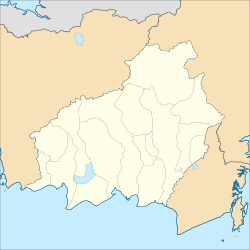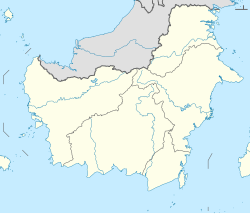Top Qs
Timeline
Chat
Perspective
Tjilik Riwut Airport
Airport in Palangkaraya, Central Kalimantan, Indonesia From Wikipedia, the free encyclopedia
Remove ads
Tjilik Riwut Airport (IATA: PKY, ICAO: WAGG), formerly Panarung Airport, is a domestic airport serving Palangkaraya, the capital city of Central Kalimantan, Indonesia. Located approximately 4.5 km (2.8 miles) from the center of Palangkaraya, the airport is named after Anakletus Tjilik Riwut, an Indonesian Air Force officer and politician of Dayak Ngaju descent. He served as the second governor of Central Kalimantan and is recognized as a national hero of Indonesia. As the largest and busiest airport in Central Kalimantan, it serves as the primary gateway to Palangkaraya and one of the main points of entry to the province. The airport offers regular flights to major Indonesian cities such as Jakarta, Semarang, and Surabaya, and also connects to remote areas in the interior of Kalimantan.
In addition to serving commercial flights, the airport also hosts the Angkasa Aviation Academy, a pilot training school operated by the Lion Air Group.[3] It is the second branch of the academy, following the first campus located at Penggung Airport in Cirebon.[4]
Remove ads
History
Summarize
Perspective
Tjilik Riwut Airport was originally known as Panarung Airfield, established on May 1, 1958, and officially inaugurated by Tjilik Riwut, who was then the Resident of Central Kalimantan. At the time, it was classified as a rural airfield and could only serve limited rural flights using small aircraft such as the Twin Otter.[5] On September 24, 1973, the Central Kalimantan regional government officially handed over the airfield to the Directorate General of Civil Aviation under the Ministry of Transportation. Following the transfer, full administrative responsibility shifted from the regional to the central government. As a result, the Minister of Transportation at the time, Emil Salim, designated Panarung Airfield as a domestic airport, enabling it to accommodate larger aircraft such as the Fokker 27.
In November 1988, Tjilik Riwut was officially designated a National Hero of Indonesia through Presidential Decree No. 108/TK/1988. He was already a well-respected figure among the people of Central Kalimantan, known for his role as a freedom fighter during the Indonesian National Revolution.[6] Tjilik Riwut initially served as a member of the Central Indonesian National Committee (KNIP) before joining the Indonesian Air Force, where he rose to the rank of Major and later Air Commodore. He played a key role in the fight against Dutch colonial forces and led the first parachute operation in Indonesian military history.[6] He was also instrumental in fully integrating the Dutch-controlled territories in Borneo into the Republic of Indonesia. Tjilik Riwut later became the second governor of Central Kalimantan. To honor his legacy, the name of Panarung Airfield was officially changed to Tjilik Riwut Airport on Heroes' Day, November 10, 1988. The renaming was formalized by the Minister of Transportation at the time, Azwar Anas.[7]
On January 1, 2019, the Minister of Transportation transferred the operations of the airport from the Directorate General of Civil Aviation to Angkasa Pura II, now known as InJourney Airports.[8]
Following the opening of the new terminal in 2019, all passenger flights were relocated there, leaving the old terminal abandoned and increasingly overgrown with vegetation. Although there are plans to convert the old terminal into a cargo facility, these have yet to be implemented.[9] There are also proposals to repurpose the building as an Emergency Operations Center, which would function as a command hub for managing critical situations such as aircraft hijackings, accidents, and other emergencies. In addition, it is intended to serve as a coordination center for the National Agency for Disaster Countermeasure (BNPB) and helicopter operators during forest fire response operations.[10]
Remove ads
Facilities and development
Summarize
Perspective
To accommodate the increasing number of passengers, a new terminal was built to replace the old one. Construction began in 2014 and took 4.5 years to complete.[11] The new terminal spans 29,124 m², significantly larger than the old terminal, which covered only 3,865 m².[12] It has the capacity to handle up to 4.5 million passengers annually. The terminal is also equipped with three jetbridges, previously used at Soekarno-Hatta International Airport.[13] Additionally, the project involved constructing new taxiways and expanding the aprons to accommodate more aircraft, as well as extending the runway to 2,600 m.[14] A total investment of around 700 billion Rupiah was allocated for the terminal and associated infrastructure. The new terminal was completed and officially inaugurated by then-President Joko Widodo on April 8, 2019.[12]
Angkasa Pura II has allocated an additional 480 billion Rupiah for further development projects at the airport, including plans to extend the runway by 400 m to 3,000 me to accommodate wide-body aircraft.[12] Other proposed developments under consideration include the construction of MRO (Maintenance, Repair, and Overhaul) facilities, a new cargo terminal, airport hotels, and various supporting amenities.[14]
Remove ads
Airlines and destinations
Passenger
Traffic and statistics

Traffic
Statistics
Remove ads
Accidents and incidents
- On 29 August 2011, Garuda Indonesia flight GA551, a Boeing 737-500 carrying 96 passengers to Jakarta, was forced to return to Palangkaraya approximately 15 minutes after takeoff due to a malfunction in the cabin cooling system. The issue was only detected after the aircraft departed from Palangkaraya at 08:04 local time.[20]
- On 22 April 2012, Garuda Indonesia flight GA550, a Boeing 737-800 from Jakarta, struck an eagle during its approach to Palangkaraya. Although there were no injuries, the aircraft's nose cone sustained damage. As a result, the plane was unable to operate the return flight to Jakarta. Passengers on the return leg were eventually flown out at 20:00 local time using a replacement aircraft dispatched from Jakarta.[21]
- On 14 December 2016, a Lion Air Boeing 737-900ER operating flight JT 0866 from Jakarta to Palangkaraya became stuck on the runway after its landing gear sank into the asphalt. The incident temporarily closed the runway, resulting in four flight delays and one diversion. The aircraft was successfully removed from the runway after being stuck for approximately 1.5 hours.[22]
Remove ads
References
External links
Wikiwand - on
Seamless Wikipedia browsing. On steroids.
Remove ads






